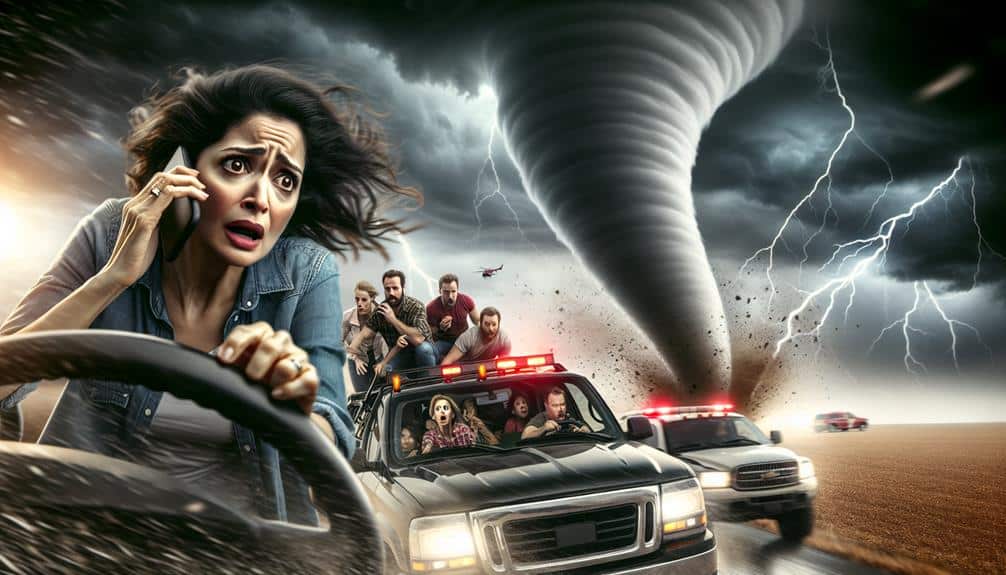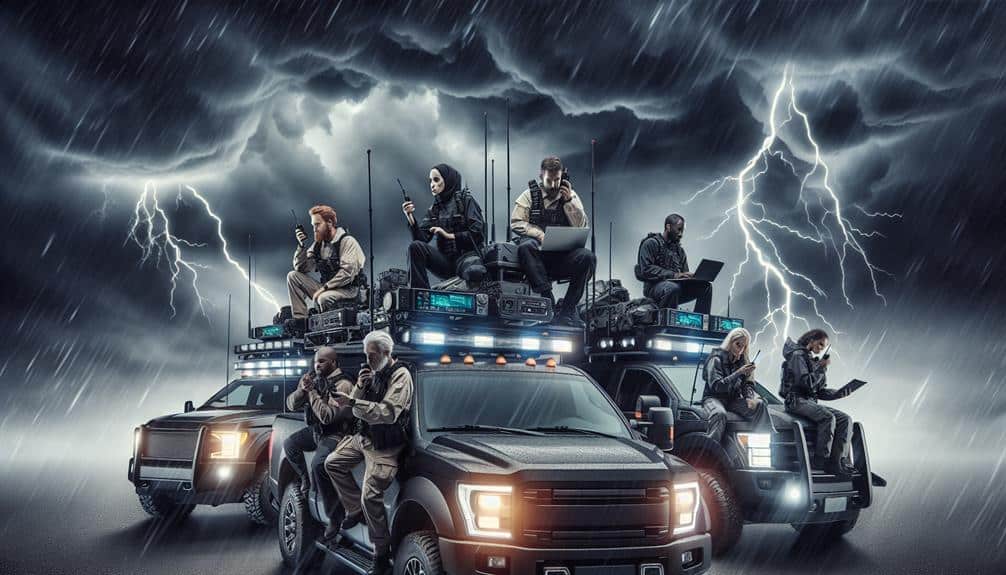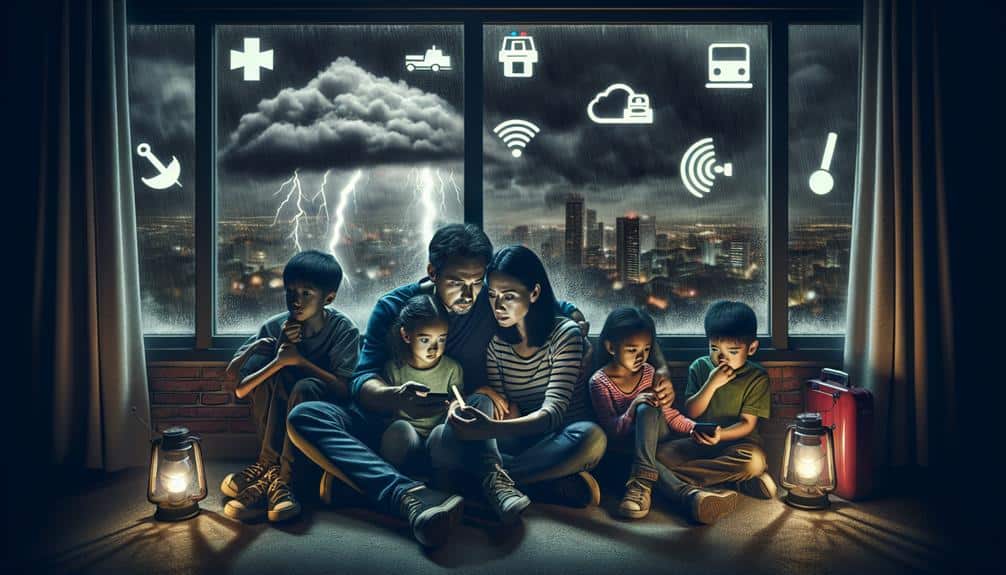We can maximize social media for storm emergency communication by engaging with local authorities and our community to guarantee accurate updates. Real-time alerts enhance public safety by promptly delivering critical information. By coordinating evacuation routes and shelter availability through immediate updates and interactive tools, we guarantee safe navigation and access to resources. Using relevant hashtags and verifying information builds trust and broadens our reach. Leveraging multimedia like live videos and infographics keeps our audience informed and engaged. Let's explore these tactics further to strengthen our emergency response.
Key Points
- Utilize real-time updates on social media to provide immediate weather alerts and critical safety information.
- Engage with the community and local authorities to ensure accurate and timely storm communication.
- Share real-time updates on evacuation routes, road closures, and new routes using clear language and visual aids.
- Notify community members about current shelter availability through up-to-the-minute social media updates and interactive maps.
Engaging With Local Authorities
Engaging with local authorities guarantees that our storm emergency communication is accurate and timely. By fostering community partnerships and encouraging citizen engagement, we can make sure that essential information reaches everyone swiftly. When emergencies strike, the strength of our community involvement and authority collaboration becomes evident. We're not just relying on one source; we're pooling resources, expertise, and local knowledge to create a robust communication network.
Community partnerships are fundamental. They allow us to tap into established trust and networks that can amplify our messages. By working closely with local authorities, we can tailor our communications to the specific needs and concerns of our community. This collaboration ensures that our social media updates aren't only relevant but also actionable.
Citizen engagement is equally important. When we involve the community in our emergency communication plans, we empower individuals to take proactive steps. This two-way communication fosters a sense of ownership and responsibility, making our collective response more efficient.
Real-Time Updates
Let's harness social media to provide real-time updates during storms, ensuring our community receives immediate weather alerts, evacuation route changes, and shelter availability notices.
By sharing these critical updates promptly, we can enhance public safety and streamline emergency response efforts.
Staying connected and informed can make all the difference in a crisis.
Immediate Weather Alerts
Real-time updates on social media can save lives during a storm by providing immediate weather alerts to the community. By leveraging platforms like Twitter, Facebook, and Instagram, we can guarantee that emergency notifications reach people instantly.
Community partnerships play a critical role in this process, as local businesses, schools, and organizations can amplify these alerts to their followers, ensuring a wider reach.
When it comes to delivering immediate weather alerts, here's what we need to focus on:
- Timeliness: Guarantee updates are posted as soon as new information is available.
- Accuracy: Double-check information before sharing to avoid spreading misinformation.
- Clarity: Use simple, direct language so that everyone understands the message.
- Reach: Utilize community partnerships to broaden the alert distribution network.
Evacuation Route Changes
During a storm, we must provide real-time updates on evacuation route changes to make sure everyone can navigate safely. Effective communication strategies are essential for securing our community stays informed and can react promptly. Social media platforms like Twitter, Facebook, and Instagram offer the immediacy we need to broadcast these updates efficiently. By leveraging these tools, we can alert everyone to road closures, new evacuation routes, and any changes in real-time.
Community involvement is key. We encourage local residents to share our posts and updates, creating a network of informed individuals who can help spread vital information quickly. This collective effort amplifies our reach and makes certain that even those without direct access to official channels are kept in the loop.
We must also use clear, concise language in our updates to avoid confusion. Visual aids like maps and infographics can be particularly effective in illustrating complex route changes. By being proactive and transparent, we build trust within our community, empowering them to make informed decisions swiftly.
Our ultimate goal is to make sure everyone's safety by providing the most accurate, up-to-date information possible during these critical moments.
Shelter Availability Notices
We must consistently provide up-to-the-minute updates on shelter availability to make sure everyone knows where to find safe refuge. During emergencies, timely information is essential. By leveraging social media, we can quickly disseminate updates about available shelters, securing our community stays informed and safe.
To maximize the effectiveness of our communication, we should focus on the following:
- Real-Time Updates: Post frequent updates on shelter locations, capacity, and any changes. This secures everyone has the latest information.
- Interactive Maps: Use interactive maps to show shelter locations and their status. This visual aid helps people find the nearest available shelter quickly.
- Community Resources: Share information about additional community resources such as food, water, and medical assistance available at shelters.
- Engage Volunteers: Encourage volunteer assistance by highlighting needs and opportunities for involvement in our emergency response efforts.

Let's focus on how we can effectively utilize hashtags for storm emergency communication.
We should prioritize a strategy for selecting relevant hashtags and leveraging trending ones to maximize visibility and reach.
Hashtag Selection Strategy
Selecting the right hashtags is vital for guaranteeing that storm emergency communications reach the widest possible audience. We can't afford to miss anyone in critical situations, and that's where hashtag analytics and targeted audience engagement come into play.
Analyzing the performance of hashtags helps us identify which ones resonate most with our community.
To develop an effective hashtag selection strategy, we should:
- Analyze Past Performance: Use hashtag analytics tools to review which hashtags performed well during past storms.
- Focus on Relevance: Guarantee the hashtags are directly related to the storm and emergency response to maintain targeted audience engagement.
- Monitor Hashtag Usage: Regularly check which hashtags are gaining traction using hashtag tracking, so we can adapt our strategy in real-time.
- Optimize for Visibility: Apply optimization techniques by mixing popular hashtags with less common but highly relevant ones to broaden our reach without getting lost in the noise.
In leveraging trending hashtags, it's crucial to stay informed about which tags are presently gaining traction to guarantee our storm emergency messages are timely and widely disseminated. By tapping into trending topics, we can enhance our social media outreach and secure our updates reach the maximum number of people. This approach plays a vital role in a storm emergency when rapid information dissemination can save lives.
We should monitor social media platforms for viral trends related to weather events, disasters, and emergency responses. Using these trending hashtags can greatly boost hashtag engagement, making our posts more visible and shareable. It's not just about using any popular tag; it's about selecting those that align with our message and the immediate needs of our audience.
In addition, we must be proactive in creating hashtags that might trend within our communities. By consistently using and promoting these tags, we can establish a reliable source of information that people will turn to during emergencies. This dual strategy of leveraging existing trends and creating new ones assures our communication remains relevant and impactful, empowering our audience with the freedom to access critical information quickly and efficiently.
Coordinating Evacuation Efforts
Effective coordination of evacuation efforts during a storm relies on the timely dissemination of clear, actionable information through social media channels. We must make sure that our messages are precise and reach the widest possible audience to facilitate swift and organized evacuations. Utilizing social media for evacuation coordination can make a significant difference in how quickly and safely communities can respond to storm threats.
To maximize our efforts, we should focus on the following strategies:
- Real-time Updates: Post frequent updates about evacuation routes, shelter locations, and road closures. This keeps everyone informed and able to act swiftly.
- Engage Community Support: Encourage community members to share posts and updates, amplifying the reach of critical information. The more eyes on our posts, the better.
- Utilize Visuals: Use maps, infographics, and videos to demonstrate evacuation routes and procedures. Visual content can often convey complex information more effectively than text alone.
- Direct Communication: Leverage live streams and Q&A sessions to address concerns and provide immediate responses to questions from the community.
Verifying Information

Maintaining the accuracy of information shared on social media during a storm is essential for preserving public trust and safety. We need to prioritize fact checking to prevent the spread of misinformation. In the chaos of a storm, rumors can spread rapidly, causing unnecessary panic or dangerous complacency. Our role is to guarantee that every piece of information we share has been thoroughly verified.
First, we should cross-reference reports with credible sources like the National Weather Service or local emergency management agencies. By doing this, we not only provide accurate updates but also reinforce the credibility of our social media channels. We can also use tools designed for fact checking, such as reverse image searches and verification software, to confirm the authenticity of photos and videos circulating online.
Additionally, actively engaging in rumor control is essential. By quickly addressing and debunking false information, we can prevent its spread. A dedicated team should monitor social media for emerging rumors and respond with verified information to set the record straight. This proactive approach helps maintain a well-informed public, guaranteeing that individuals can make safe, informed decisions during the storm.
Leveraging Multimedia
We can harness the power of multimedia to deliver clear, compelling emergency updates during a storm. By utilizing various forms of media, we guarantee our messages are both informative and engaging, reaching people where they're most active. Here's how we can effectively use multimedia:
- Interactive Maps: They provide real-time tracking of the storm's path, helping people visualize potential impacts on their specific locations. Users can zoom in and out, giving them the freedom to explore detailed information.
- Live Videos: Broadcasting live updates keeps everyone informed with the latest developments. It allows for real-time interaction, where viewers can ask questions and receive immediate responses, enhancing their sense of control and preparedness.
- Infographics: These are perfect for conveying complex information quickly and clearly. Well-designed infographics can summarize safety tips, emergency procedures, and resource locations, making it easy for people to digest and act on the information.
- Photo Albums: Sharing curated photo albums of the storm's progression and its aftermath can provide powerful visual evidence. This not only informs but also emotionally connects with the audience, driving home the urgency and importance of the updates.
Frequently Asked Questions
How Can We Ensure Messages Reach Non-English Speaking Communities?
We need to hit the nail on the head with translation services and community outreach. By partnering with local leaders and leveraging technology, we can guarantee our messages reach non-English speaking communities effectively and promptly.
What Are the Best Practices for Scheduling Posts During a Storm?
For scheduling posts during a storm, let's develop a content strategy that prioritizes timely updates. We should use engagement tactics like real-time interactions and multilingual posts to guarantee our audience stays informed and safe.
How Can We Protect Our Social Media Accounts From Cyber Threats During an Emergency?
We need to bolster account security to guard against cyber threats. Enabling two-factor authentication, monitoring for suspicious activity, and educating our team on data privacy and online safety will help protect our social media accounts during emergencies.
What Tools Can Automate Our Social Media Responses Effectively?
We should use social media tools for automating responses and scheduling practices. These tools can enhance cybersecurity, reach non-English communities, and measure impact effectively. This guarantees our communication is timely and secure during emergencies.
How Do We Measure the Impact of Our Social Media Communication During a Storm?
How do we measure the impact of our social media communication during a storm? We focus on impact measurement and engagement analysis, track audience reach, and address language barriers to guarantee our message resonates and reaches everyone effectively.


